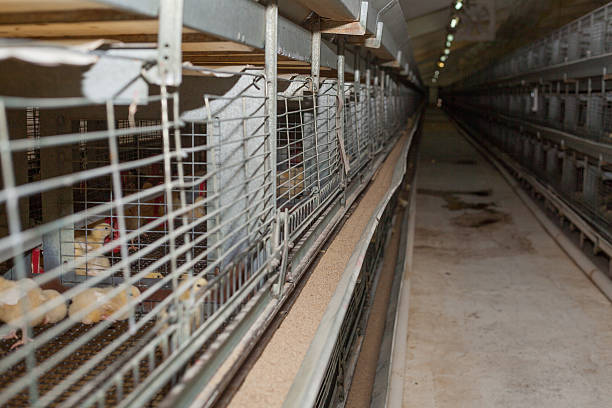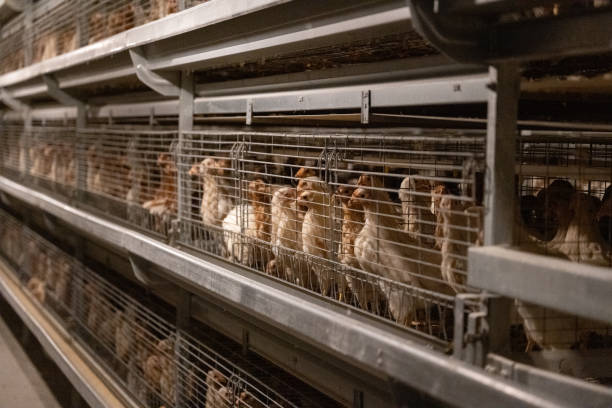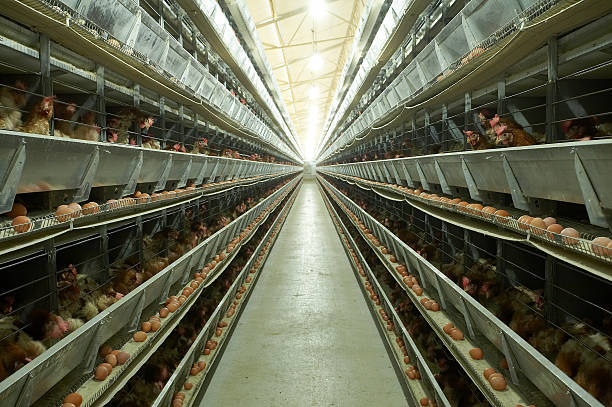
Cost-Effective Cage Systems for a 10,000-Bird Poultry Operation in Africa
Cost-Effective Cage Systems for a 10,000-Bird Poultry Operation in Africa
Starting a poultry business in Africa, especially with a flock as considerable as 10,000 birds, demands careful planning and a shrewd investment strategy. One of the most crucial decisions you’ll make is choosing the right housing system. While free-range systems have their appeal, cage systems, particularly those designed for egg-laying or broiler chickens, often present a more cost-effective and manageable solution for large-scale operations. This article delves into the key aspects of selecting and implementing cost-effective cage systems for a 10,000-bird poultry farm in the African context, considering factors like initial investment, operational costs, maintenance, and local market demands.
Why Choose Cage Systems?
Before diving into the specifics, it’s essential to understand why cage systems are often favored for large-scale poultry farming. They offer several advantages:

Higher Bird Density: Cage systems allow you to house more birds in a given area compared to floor or free-range systems. This translates to lower land costs and more efficient use of space.
Improved Hygiene: Birds in cages have less contact with their droppings, reducing the risk of disease outbreaks and improving overall hygiene. Cleaning and sanitation are also generally easier.
Better Egg Collection: For egg-laying hens, cage systems streamline egg collection. Eggs roll out of the cages onto a collection belt, minimizing breakage and labor costs.
Reduced Feed Wastage: The design of cage feeders minimizes feed spillage, ensuring that birds receive adequate nutrition without unnecessary waste.
Easier Management: Cage systems simplify bird management. It’s easier to monitor individual bird health, administer medications, and track egg production.
Predator Protection: Cages provide protection from predators like foxes, snakes, and birds of prey, which can be a significant issue in some African regions.
Controlled Environment: Although often open-sided in Africa, cages offer better control over the environment in comparison to free-range. You can more easily manage ventilation and protect birds from extreme weather.
Types of Cage Systems for a 10,000-Bird Operation
The two primary types of cage systems relevant to a 10,000-bird operation are those for egg-laying hens (layer cages) and those for broiler chickens (broiler cages).
Layer Cages:
Layer cages are designed to optimize egg production. Common configurations include:
A-Frame Cages: These cages are arranged in an “A” shape, with tiers stacked on top of each other. They are relatively inexpensive and easy to install.
H-Frame Cages: H-frame cages offer better ventilation and light distribution compared to A-frame cages. They are also easier to clean.
Stacked or Tiered Cages: These systems maximize space utilization by stacking multiple tiers of cages vertically. They often incorporate automated systems for feeding, watering, and egg collection.
Broiler Cages:
Broiler cages are designed to optimize meat production. Since broiler chickens grow quickly, the cage design focuses on easy access to feed and water, and good ventilation.
Flat Deck Cages: A simple and cost-effective option for broiler production, providing ease of access for both birds and farm staff.
Multi-Tiered Broiler Cages: These can increase the number of birds per square meter, maximizing space utilization, but may require more sophisticated ventilation and waste management systems.
Factors to Consider When Choosing a Cage System
Selecting the right cage system for your 10,000-bird poultry operation is a critical decision. Consider the following factors:
Budget: Cage systems vary significantly in price. Determine your budget upfront and look for systems that offer the best value for your money. Don’t just focus on the initial cost; consider the long-term operational costs as well.
Bird Welfare: While cage systems sometimes face criticism regarding animal welfare, modern designs prioritize bird comfort. Look for cages with adequate space, proper ventilation, and comfortable flooring. Ensure the birds have easy access to food and water.
Climate: The African climate can be harsh, with high temperatures and humidity in many regions. Choose a cage system that provides adequate ventilation to prevent heat stress. Consider incorporating cooling systems, such as fans or evaporative coolers, if necessary.
Local Regulations: Research local regulations regarding poultry farming and cage systems. Ensure that your chosen system complies with all applicable laws and standards.
Maintenance: Opt for a cage system that is easy to maintain. Consider the availability of spare parts and the complexity of repairs.
Automation: Automated systems for feeding, watering, and egg collection can significantly reduce labor costs. However, they also require a higher initial investment and may be more complex to maintain. Weigh the pros and cons carefully.
Manure Management: Efficient manure management is crucial for hygiene and environmental sustainability. Choose a cage system that facilitates easy manure removal and disposal. Consider composting or other methods of manure treatment.
Durability: The cage system should be robust and durable to withstand the harsh conditions of poultry farming and African climates. Look for cages made from high-quality materials that are resistant to corrosion.
Expandability: Consider the potential for future expansion. Choose a cage system that can be easily expanded if you decide to increase your flock size.
Supplier Reputation: Choose a reputable supplier with a proven track record. Look for a supplier who offers good customer support and provides warranties on their products.
Cost-Effective Strategies for Implementation
Here are some strategies to make your cage system implementation more cost-effective:
Source Locally: If possible, source materials and components locally to reduce transportation costs. However, ensure that the quality of locally sourced materials meets your standards.
Negotiate Prices: Don’t be afraid to negotiate prices with suppliers. Compare quotes from multiple suppliers to ensure you are getting the best deal.
Phased Implementation: Consider implementing the cage system in phases to spread out the cost. Start with a smaller section of your poultry house and gradually expand as your business grows.

DIY Construction: If you have the skills and resources, consider constructing some parts of the cage system yourself. This can significantly reduce the overall cost. Employing local welders and fabricators can be a great way to save money while also boosting the local economy.
Energy Efficiency: Implement energy-efficient lighting and ventilation systems to reduce operating costs. Consider using solar power to generate electricity.
Proper Training: Provide adequate training to your staff on the operation and maintenance of the cage system. This will help to prevent breakdowns and extend the lifespan of the equipment.
Preventative Maintenance: Establish a preventative maintenance schedule to identify and address potential problems before they become major issues. This will help to reduce repair costs and downtime.
Bulk Purchasing: Purchase feed and other supplies in bulk to take advantage of discounts.
Specific Considerations for the African Context
Several factors are unique to the African context that should be considered when choosing a cage system:
Power Supply: In many African countries, the power supply is unreliable. Consider investing in a backup generator to ensure that your poultry house remains operational during power outages. This is especially critical for automated systems.
Water Availability: Water scarcity is a major issue in some parts of Africa. Implement water conservation measures, such as using nipple drinkers, to minimize water wastage. Consider investing in a water storage tank to ensure a reliable water supply.
Security: Security can be a concern in some areas. Implement security measures, such as fencing and security guards, to protect your poultry farm from theft and vandalism.
Local Expertise: Engage local experts, such as veterinarians and agricultural extension officers, to provide advice and support. They can help you to adapt your farming practices to the local context.

Market Access: Ensure that you have access to a reliable market for your eggs or meat. Establish relationships with local wholesalers, retailers, and restaurants.
Cost Analysis Example for a 10,000-Bird Layer Operation (Illustrative)
This is a simplified estimate. Actual costs will vary depending on location, supplier, and specific choices.
Cage System (A-Frame, Semi-Automated): \$20,000 – \$30,000 (This includes cages, feeders, drinkers, egg collection system – partial automation).
Poultry House Construction: \$15,000 – \$25,000 (Simple structure with adequate ventilation).
Feed Storage: \$2,000 – \$4,000
Water Storage: \$1,000 – \$2,000
Initial Stock (10,000 pullets): \$30,000 – \$50,000 (This is a significant cost; shop around for good quality pullets).
Contingency (10%): \$6,800 – \$11,100
Total Estimated Initial Investment: \$74,800 – \$122,100
Ongoing Costs (per month):
Feed: \$8,000 – \$12,000 (This is your biggest ongoing expense. Feed efficiency is crucial).
Labor: \$1,000 – \$2,000 (Depending on automation level and number of employees).
Utilities (electricity, water): \$500 – \$1,000
Medication & Veterinary: \$200 – \$500
Maintenance & Repairs: \$100 – \$300
Conclusion
Choosing a cost-effective cage system for a 10,000-bird poultry operation in Africa requires careful consideration of numerous factors, including budget, bird welfare, climate, local regulations, and maintenance. By implementing cost-saving strategies, sourcing materials locally, and prioritizing energy efficiency, you can maximize your profitability and ensure the long-term sustainability of your poultry farm. Remember to adapt your practices to the specific challenges and opportunities presented by the African context, and seek advice from local experts to ensure your success. Ultimately, a well-planned and executed cage system can provide a solid foundation for a thriving poultry business.
